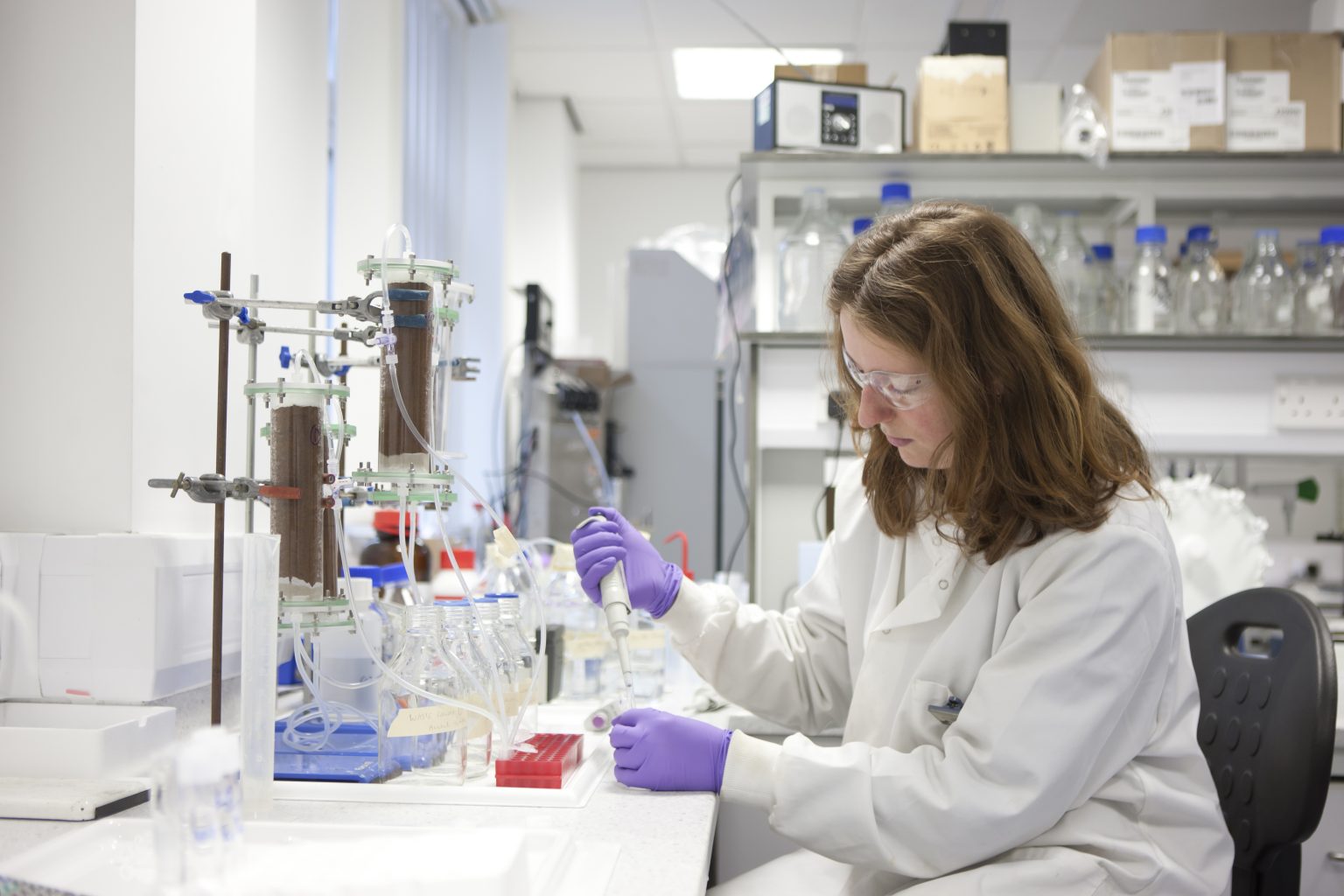Overview
The Dalton Cumbrian Facility (DCF) is an established centre of radiation science and host to the Royce Irradiation Environments Technology Platform. The facility allows the research community to study and grow understanding of the complex interactions between ionising radiation and materials or processes. To enable this research, DCF houses large-scale sources of ionising radiation and a range of material modification, characterisation, and analytical equipment. The facility has a dedicated on-site team of research-active experimentalists to help the community to design, develop and deliver experiments to a high standard and to interpret data and outcomes. As well as being part of the Henry Royce Institute, DCF is a partner in the EPSRC UK National Ion Beam Centre and the National Nuclear User Facility.
Purpose – Our purpose is to foster and support the understanding of radiation-driven processes and the responsible use of radiation.
Vision – Our vision, as a leading hub for the UK radiation science community, is to support innovation in applications of radiation science and engineering. We perform cutting-edge research and skills development, engaging directly with our users, supporting an ever-growing community through modelling, planning and execution of experiments involving ionising radiations.
Through the Henry Royce Institute, DCF offers facilities able to support all the research areas where there is an interest in behaviour of materials in radiation environments. This is particularly of relevance to 2D materials, advanced materials processing, biomedical materials, materials systems for demanding environments, and nuclear materials.

Capability
Ion Beam Technology
DCF houses two accelerators, 5-MV tandem and 2.5-MV single-ended Pelletrons, configured to provide a range of ion irradiation and analysis capabilities across eight beam lines. Ion beam irradiation allows for rapid achievement of materials damage levels accumulated during many years of in-service exposure and provides data on the effects of radiation under very specific conditions of temperature, radiation dose rate and radiation dose.
The 5-MV tandem (model 15SDH-4 from NEC) has two sources and six beam lines:
- Toroidal volume ion source (TORVIS) can generate up to 100μA of proton current (up to 10MeV), or 1μA of He ion (α) current (up to 15MeV)
- Multi-cathode source of negative ions by caesium sputtering (MC-SNICS) for the production of heavy ion beams (up to 35MeV); provides up to 50 hours of continuous beam at constant current with 20 cathodes per wheel for quick changeover
- Ion beam analysis: an NEC RC43 end-station incorporates PIXE (Particle Induced X-ray Emission), RBS (Rutherford Backscattering Spectroscopy), ERD (Elastic Recoil Detection), and NRA (Nuclear Reaction Analysis)
The 2.5-MV Pelletron (model 7.5SH-2 from NEC) is a source of high current (100μA) proton or helium ion beams, and other noble gas ion beams eg krypton and xenon. It shares its two end-stations with two from the larger accelerator, enabling future dual ion beam capability to allow for creation of damage effects (from heavy ion bombardment) whilst simultaneously maintaining a radiation-rich field. One beam line, capable of single or dual beam radiation damage, has built-in Secondary Ion Mass Spectroscopy (SIMS) and Electron Energy Loss Spectroscopy (EELS) analysis currently under development.
A bespoke fluid recirculation loop that operates at high temperature and pressure can be coupled to an ion beam end station, allowing for extreme conditions relevant to nuclear reactor coolant to be probed.
Photons
Gamma Irradiator (Foss Therapy Services Model 812)
Our high dose rate cobalt-60 gamma irradiator is designed and operated to support a wide range of research applications with the aim of developing understanding of the mechanistic effects of gamma radiation on materials, systems and components. The instrument is capable of delivering dose rates from around 25kGy/h to less than 100Gy/h.
Example research areas are:
- effects of gamma radiation on nuclear waste forms and waste storage media
- long-term radiation effects on graphite; development of moderators for future reactor designs
- polymers – irradiation can enhance or deteriorate mechanical characteristics
- effects of gamma radiation on biomedical materials
- radiation hardness testing of electronics and microelectronics
A bespoke fluid recirculation loop that operates at high temperature and pressure can be fed through the gamma irradiator service ports and coupled to an autoclave (can withstand up to 350°C and 220 bar), allowing for extreme conditions relevant to nuclear reactor coolant to be probed
For experiments where lower energy photons are more applicable, our Precision X-Ray Multi-Rad 350 irradiator is capable of dose rates up to 140Gy/min (unfiltered beam):
- Maximum dose rate 24Gy/min (filtered beam)
- Broad X-ray energy spectrum provided by Bremsstrahlung, after accelerating an electron beam onto a tungsten plate
- Peak X-ray energies are approximately 10-115keV (electron acceleration voltage 30-350keV)
- Electron current of 0.1-30mA (maximum total power is 4kW)
- Irradiation chamber measures 41cm wide by 88cm deep and 58cm high
- Automatic dose rate sensing, a range of apertures, and a turntable to improve dose homogeneity
- Insertion chambers can be used to change the gas atmosphere (eg CO2 or hypoxic)
- Access ports allow for connection to external instruments
Analysis and Characterisation
We provide fully equipped analytical and characterisation laboratories for a wide range of material examination, including pre- and post-irradiation.
Equipment available includes:
- Scanning electron microscopy (Quanta 250 FEG ESEM) with EBSD, EDX, WDS detectors
- Spark Plasma Sintering system (vacuum, Ar, N, atmosphere, up to 100MPa and 2000oC) is available for custom pellet preparation
- Panalytical Empyrean K-alpha X-Ray Diffraction system with Pixcel 3D detector (reflection/transmission mode; 2D XRD; powder, thin film, microbeam, texture analysis, non-ambient, capillary stage available)
- Helium pycnometery for volume and density measurements
- Bruker Vertex series FTIR coupled with Ram II for macro Raman of liquids, solids or powders
- Dispersive Raman microscope with a choice of 3 lasers (532, 633 or 785nm), Ramanscope attachment enables FT Raman microscopy when coupled to the Ram II liquid nitrogen-cooled detector
- Setaram LabsysTM Evo for Thermogravimetric (TGA)/Calorimetric (DSC) analysis coupled with a Hiden EGA Mass Spectrometer, delivering qualitative and quantitative information about thermal effects in materials in correlation with their structure and composition
- Gas chromatography with flame ionisation, thermal conductivity and electron capture detectors. A PAL3 autosampler allows rapid analysis from samples in crimp-cap vials
- Ion Chromatography, a cation-separating chromatograph and an anion-separating chromatograph with attached autosampler that can inject into either chromatograph or both in sequential mode
- High-performance liquid chromatography (Agilent 1260 with UV/Vis absorption detector)
- UV/Visible/Near Infrared absorbance spectrometer with diffuse reflectance accessory for solids and powders (wavelengths from 175 to 3300nm)
- Fluorescence spectrometer with liquid, powder and monolith sample holders (wavelengths from 190 to 900nm)
- X-ray imaging provides energies from 10-100kV for imaging a range of low-density materials. Imaging area up to 23x29cm and spatial resolution of 5µm at 10 times magnification
- EPR X-band spectrometer for studying paramagnetic molecules such as free radicals and transition metal ions with variable temperature unit for 100-373K measurements
- Microplate reader for absorbance, fluorescence, fluorescence polarisation or luminescence measurements of up to 96 well plates in the range 220-1000nm
- A range of 3D printers, plus high-quality and high-precision equipment to do sample preparation pre- and post-irradiation



